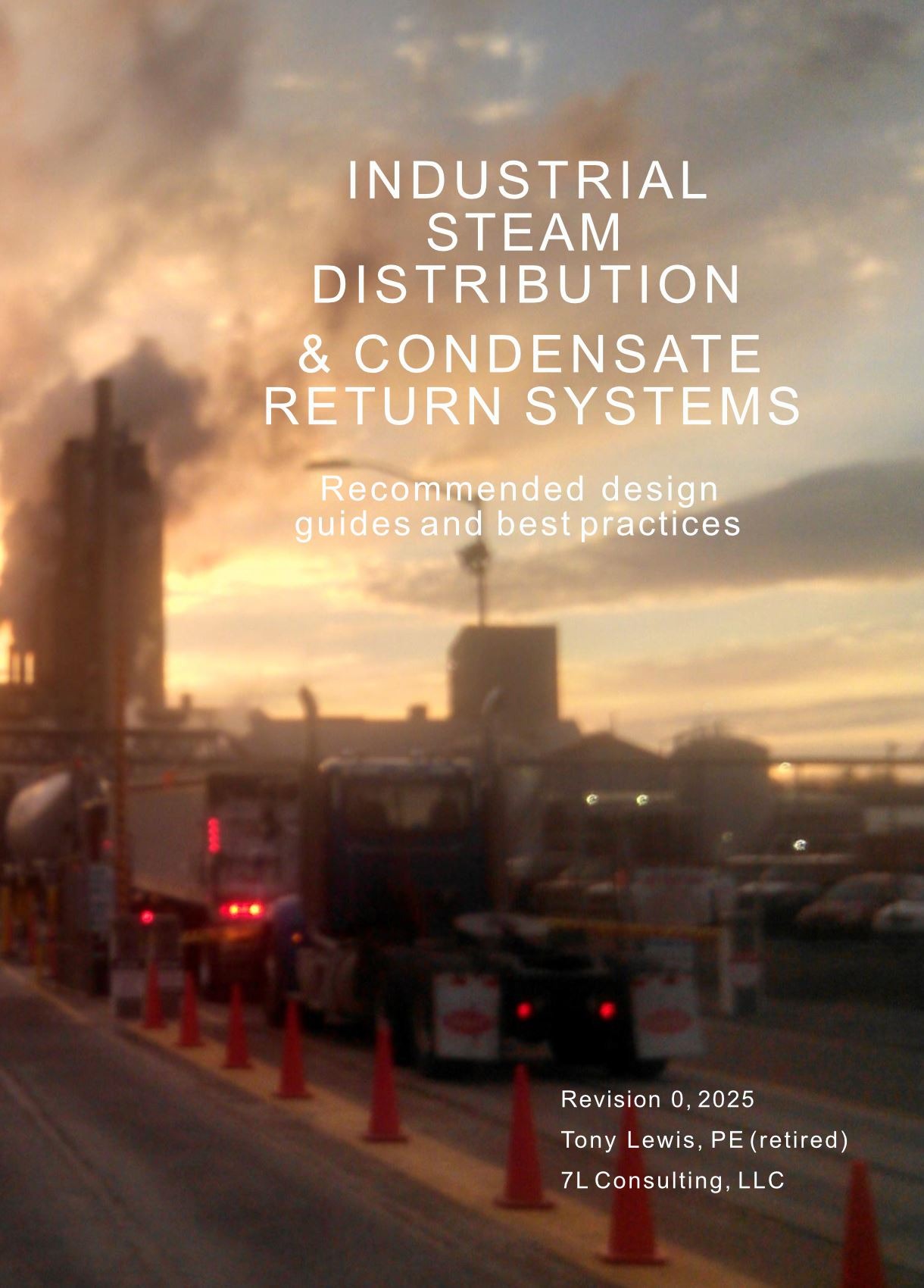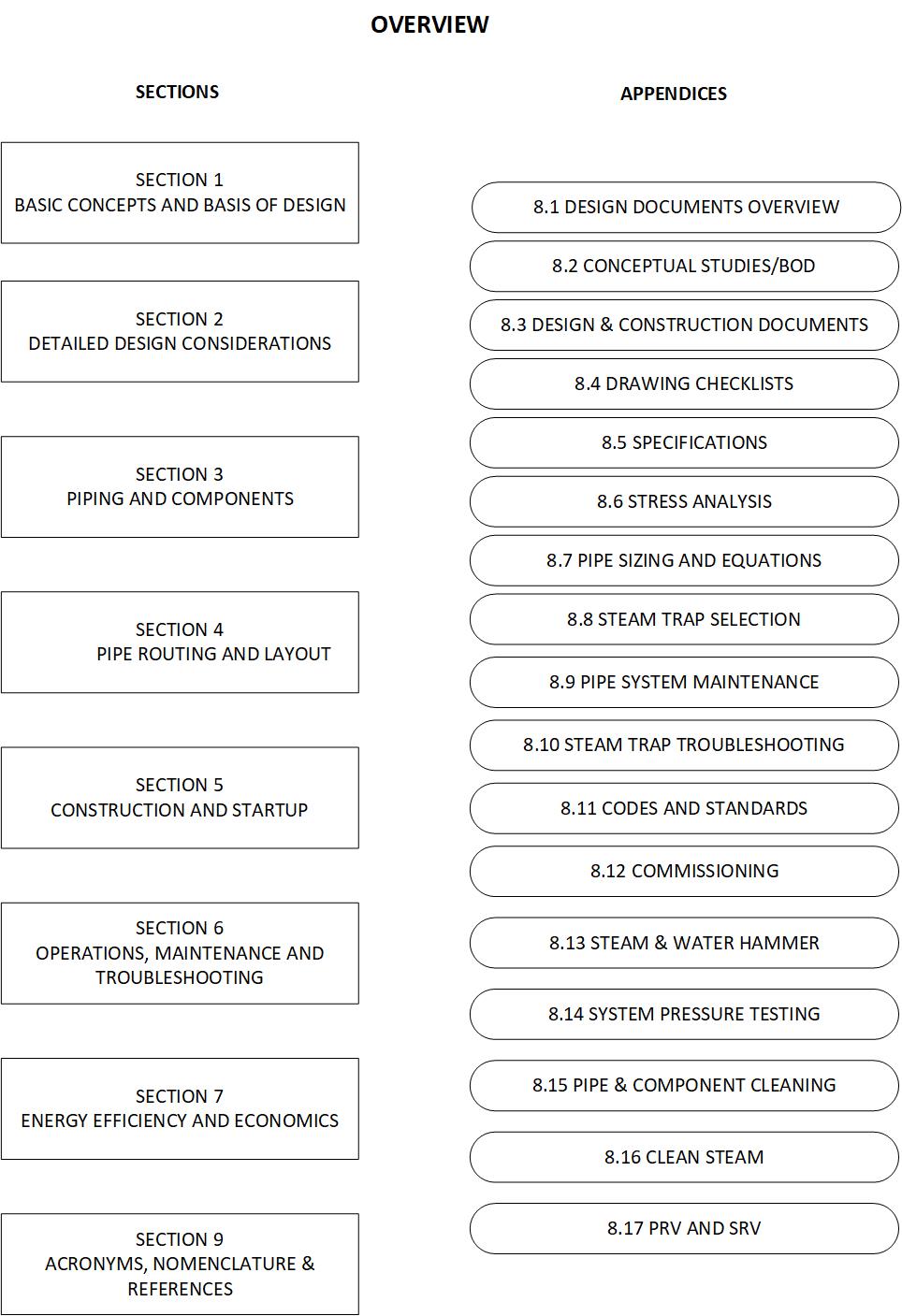INDUSTRIAL STEAM DISTRIBUTION AND CONDENSATE RETURN SYSTEMS
Recommended design guides and best practices
by Tony Lewis, PE (retired), 2025
This book is currently undergoing final formatting, and should be available for purchase prior to the end of 2025 on Amazon. The book Preface, cover, and diagram of major book sections is provided here to illustrate the intent of the book. If you are interested, or need further information, please use the CONTACT form on this web page. Thank you for your interest.
PREFACE
Purpose
The purpose of this book is to provide a single source of design, operations, and maintenance information for large scale steam distribution and condensate return systems, such as industrial, institutional, district heating or other similar systems.
Who is the book for?
The book is predominately written for professional engineers and designers who work with steam systems. However, students, facility Owners, Operations, Maintenance and equipment Vendors will find it informative and useful as well.
What topics are covered?
The main topic of the book is the steam distribution piping system from the boiler to the end users, as well as the condensate return system from the distribution piping and end users back to the boiler room.
Individual topics include:
· Overall design and layout of the systems
· Detailed design issues, such as pipe sizing, stress analysis, etc.
· Design processes, from initial studies to construction documents
· Start up and commissioning of steam and condensate systems
· Operations, maintenance and troubleshooting of the systems and their components
· Energy efficiency and economics of steam and condensate systems
· Miscellaneous topics, such as clean/pure steam, steam trap troubleshooting, steam and water hammer, etc.
Another item of note is information is provided for steam and condensate systems located inside a building or facility, but also covers exterior piping systems as well. Exterior piping systems are further broken down into above grade and below grade systems.
What topics are not covered?
· Boilers. There are quite a few existing references available on boilers, their associated support systems (condensate receiver, deaerator, feed water pumps, chemical treatment, etc.). As such any mention of boilers or their support systems will be minimal and only noted when they impact the steam or condensate piping systems.
· Steam end users and their hook-ups. The end users of steam, whether simple coils, heat exchangers, vessels, jackets, etc. are not covered in detail, as their design, operation and maintenance are specific to the component itself. As with boilers, end users are not discussed in detail; however, their steam isolation/modulating valves, and condensate steam traps are noted on an as needed basis.
· Power systems. The steam and condensate systems covered in the book are for saturated steam, typically at pressures from 50 psig to over 300 psig. These steam systems are common in industrial systems, where the steam is used for process heating, as well as space heating. Some large scale institutional and district heating systems will also use saturated steam for distribution purposes, and then reduce the steam pressure at points of use for space heating. However, power systems utilize superheated steam for greater efficiency when used in conjunction with steam turbines to generate electrical power. The design and construction of superheated steam systems is significantly different than saturated steam systems, and is outside the scope of this book.
· Low pressure steam systems. Low pressure steam is typically below 50 psig (and also as low as atmospheric or 15 psig) and is used almost exclusively for space heating alone. Although these systems may be incorporated as a subsystem to a larger steam distribution system, they are also considered to be outside the scope of this book.
How is information laid out in the book?
Information in the book is laid out starting with the introductory data and concepts of steam and condensate systems and their components, and provides more in depth information in the latter chapters. Multiple appendices are provided with the intent of providing the most detailed information on a given topic. The intent is to allow the reader to focus on the topic (or topics) of interest without having to absorb the entire book.
As noted previously, the book does focus on the overall design process that one would follow in the development of the design for a steam and/or condensate system, and the design process, from initial studies to the completion of construction documents is presented. Note however, that topics covering the construction phase, startup, and operations, maintenance and troubleshooting are also included, along with economics and energy efficiency.
While the book is mainly focused on the design and theory of steam and condensate systems, wherever possible, general guidance and good engineering practices are provided that will aid in the system design and operations above and beyond simple formulas or tables.
What are the major sections of the book and their purpose?
There are nine major sections in the body of the book, including 17 Appendices in Section 8. A list of recommended references, nomenclature, and acronyms are provided as well in Section 9.
Section 1: Basic Concepts and Basis Of Design
Section 1 provides an introduction to the reader on the basic concepts and design of steam and condensate systems and their layout. This section is directed towards new and novice readers who have had little or no experience with steam and condensate systems.
Section 2: Detailed Design Considerations
The second section goes into greater detail and depth on the design of steam and condensate systems. Input and guidance is provided on the development of the overall design, from initial studies and BOD to the detailed design documents. Topics include pipe sizing and routing, Pressure Reducing Valves (PRVs), Safety Relief Valves (SRVs) and other design considerations based upon the size and complexity of the systems.
Section 3: Piping and Components
Section 3 is geared towards the piping used in steam and condensate systems. This includes pipe material, thickness, fabrication, and methods of joining pipe segments to each other and components. Other piping system components such as flanges and valves are discussed as well. Piping stress analysis and its relationship to the pipe and components is also covered.
Section 4: Pipe Routing and Layout
Pipe Routing and Layout focuses on the “three dimensional” aspects of designing and routing piping systems. While prior discussions have covered the piping system diagrammatically, this section discusses the more practical aspects of routing the piping for installation in the field. The pipe routing is further broken down into interior versus exterior installations. And exterior installations are also broken down into above grade and below grade installations.
Section 5: Post Design – Construction, Startup and /Commissioning
Section 5 covers the typical activities and responsibilities of the Engineer, Contractor, Owner and others during the Construction phase of a project., as well as the post construction startup and commissioning activities for steam and condensate systems.
Section 6: Operations, Maintenance and Troubleshooting
Operation, maintenance and troubleshooting of the systems and components when in service is covered next and delves into non-design issues with the steam and condensate systems after construction is complete and the systems are placed into service.
Section 7: Energy Efficiency and Economics
The last section discusses determining the costs of producing steam and condensate; these values are useful in monitoring operating and maintenance costs, justifying modifications to improve efficiency and lower operating costs, and determining the cost versus return on investment in periodic maintenance upgrades and modifications. Energy audits for steam and condensate systems are also discussed.
Appendices 8.1 through 8.17
Each appendix covers a specific topic or topics in greater detail than that covered in Sections 1 through 7. The information is provided in this manner to allow the Reader to “jump” to the areas of interest, while skipping over the topics that are not relevant at the time. The intent is to provide general information on topics in the main body of the book, and then more detailed information on topics in the Appendices.
Section 9: Acronyms, Nomenclature and References
A list of acronyms and terms are provided at the rear of the book to assist the Reader in the event that an acronym or term used in the text is not readily understood.
Explanations of terminology used in the book that may not be familiar to the reader are provided.
A list of recommended references is provided for the Reader if they wish to follow up or dig deeper into one or more topics not provided within the book.
About the Author
Tony Lewis, PE, is a retired Mechanical Engineer and Project Manager with over 40 years’ experience in various mechanical design projects. His areas of expertise include large scale, industrial and institutional central utility systems, such compressed air, chilled water, cooling tower, heating hot water, and of course, steam and condensate systems. Mr. Lewis generated this book in over a year period to provide novice as well as experienced engineers and other personnel with a single source of information on steam and condensate systems. In addition to the design guidelines, best practices and formulas, practical input is provided regarding the design, operation and maintenance of these systems, such that the Reader will view these systems on a more “holistic” level.
This book is published by Mr. Lewis’ company, 7L Consulting, LLC.
for more information. Mr. Lewis can be reached by use of the CONTACT form on this web page. He welcomes readers’ comments, questions, suggestions, etc. on the book or related topics.




